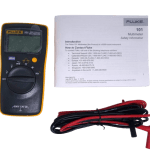Test 5 Pin Relay
Welcome to our comprehensive guide on how to test a 5 Pin Relay with a multimeter. If you’re experiencing issues with your electrical system, specifically related to the relay, this guide will provide you with step-by-step instructions on how to test the relay using a multimeter. Whether you’re a beginner or an experienced DIY enthusiast, this guide will help you diagnose and troubleshoot relay problems effectively.
Understanding What Is 5-Pin Relay
Before we dive into the testing process, let’s first understand what a 5-Pin Relay is and how it functions. A relay is an electromechanical switch that allows a low-power signal to control a high-power circuit. It acts as a bridge between the control circuit and the load circuit. The 5 pin relay pinout, is used for connecting the various electrical system components.
The 5 pins relay pinout detail is given below.
- Coil Pin 1: Connects to the positive side of the power source.
- Coil Pin 2: Connects to the negative side of the power source.
- Normally Open (NO) Pin: Connects to the load circuit when the relay is activated.
- Normally Closed (NC) Pin: Connects to the load circuit when the relay is not activated.
- Common (COM) Pin: Connects to one end of the coil and the NO/NC pins.

5 Pin Relay Pinout
The 5 Pin Relay Diagram is given below.

5 Pin Relay Diagram
Table of Contents
How to Test 5 Pin Relay
Step 1: Gather the Necessary Tools
Before you begin testing the 5 Pin Relay, make sure you have the following tools:
- Multimeter: A multimeter is an essential tool for measuring electrical values such as voltage, resistance, and continuity.

- Safety Gloves and Glasses: It’s crucial to protect yourself from any potential electrical hazards.
Step 2: Disconnect the Power Source
To ensure your safety, disconnect the power source from the circuit you’ll be working on. This step is essential to avoid any accidental electric shock.
Step 3: Identify the Relay Pins
Identify the pins on the 5 Pin Relay. You can refer to the relay’s datasheet or search online for the specific pin configuration of your relay model. Typically, the pinout information can be found on the side or bottom of the relay.
Step 4: Set the Multimeter
Set your multimeter to the appropriate settings for the test you’ll be performing. For example, if you’re testing for continuity, set the multimeter to continuity mode. If you’re testing for resistance or voltage, set it accordingly. In our case, the resistance mode is selected.

Step 5: Test the Coil
The coil is responsible for activating the relay. To test the coil:
- Place the multimeter’s red probe on one of the coil pins (Pin 1 or Pin 2) and the black probe on the other coil pin.
- Check the multimeter reading. If the reading shows continuity or a low resistance value, it indicates that the coil is functioning correctly. If there is no continuity or an open circuit, it suggests a faulty coil that needs to be replaced. In our case, the multimeter shows some resistance so the relay coil is functioning.

Step 6: Test the Contacts
The contacts of the relay determine whether the load circuit is open or closed when the relay is activated. To test the contacts:
- Place the multimeter’s red probe on the NO pin and the black probe on the COM pin.
- Activate the relay by applying a voltage to the coil pins. You can use a separate power source. such as a battery to energize the coil.
- Check the multimeter reading. If the reading shows continuity or a low resistance value, it means that the contacts are working correctly, and the load circuit is closed when the relay is activated. If there is no continuity or a high resistance value, it indicates a faulty contact that needs to be addressed. As can be seen below that the resistance is “00.0” It’s due to the contact resistance being negligible and the relay contacts are working correctly.

Step 7: Test the Normally Closed (NC) Pin
The NC pin is responsible for connecting the load circuit when the relay is not activated. To test the NC pin:
- Disconnect the power source from the relay.
- Place the multimeter’s red probe on the NC pin and the black probe on the COM pin.
- Check the multimeter reading. If the reading shows continuity or a low resistance value, it means that the NC pin is functioning correctly. If there is no continuity or a high resistance value, it suggests a faulty NC pin that requires attention.

Step 8: Test the Normally Open (NO) Pin
The NO pin is responsible for connecting the load circuit when the relay is activated. To test the NO pin:
- Disconnect the power source from the relay.
- Place the multimeter’s red probe on the NO pin and the black probe on the COM pin.
- Check the multimeter reading. If the reading shows no continuity or an open circuit, it means that the NO pin is functioning correctly. If there is continuity or a low resistance value, it suggests a faulty NO pin that needs to be addressed.

Step 9: Check for Coil Resistance
In addition to testing the individual pins, it’s essential to check the resistance of the relay coil. To do this:
- Disconnect the power source from the relay.
- Set your multimeter to measure resistance.
- Place the multimeter’s probes on the coil pins (Pin 1 and Pin 2).
- Check the multimeter reading. It should match the specified resistance value mentioned in the relay’s datasheet. If the resistance is significantly higher or lower than the specified value, it indicates a faulty coil.

Step 10: Replace or Repair the Faulty Relay
If any of the tests indicate a faulty component or if the relay fails to function correctly, it’s advisable to replace the relay with a new one or repair it if possible. Consult the manufacturer’s instructions or seek professional assistance if you’re unsure about the replacement or repair process.
FAQs
Q: How do I know if my 5 Pin Relay is faulty?
A: You can test the 5 Pin Relay using a multimeter as outlined in this guide. If the tests reveal faulty components or the relay fails to function correctly, it’s likely that the relay is faulty.
Q: Can I use any multimeter to test a 5 Pin Relay?
A: Yes, any multimeter capable of measuring resistance, continuity, and voltage can be used to test a 5 Pin Relay.
Q: Are there different types of 5 Pin Relays?
A: Yes, there are various types of 5 Pin Relays available, each with its specifications and applications. It’s important to identify the specific type and pin configuration of your relay before testing.
Q: Can a faulty 5 Pin Relay cause electrical issues in my vehicle?
A: Yes, a faulty relay can lead to electrical problems in your vehicle, such as malfunctioning lights, non-functioning components, or intermittent electrical failures.
Q: Can I repair a faulty 5 Pin Relay?
A: In some cases, it’s possible to repair a faulty 5 Pin Relay if the issue is minor and can be resolved. However, it’s often more practical and reliable to replace the relay with a new one.
Q: How often should I test my 5 Pin Relay?
A: It’s a good practice to test your 5 Pin Relay whenever you experience electrical issues in your system or as part of regular maintenance. Additionally, if you suspect a problem with the relay, testing it can help diagnose the issue.
Conclusion
Testing a 5 Pin Relay with a multimeter is a straightforward process that can help you identify faulty components and ensure the proper functioning of your electrical system. By following the steps outlined in this guide, you’ll be able to diagnose and troubleshoot relay-related issues effectively. Remember to prioritize safety by disconnecting the power source before conducting any tests.
If you encounter a faulty relay, it’s recommended to replace it with a new one or seek professional assistance if needed. Regular maintenance and periodic testing of your electrical components, including relays, can help prevent potential failures and ensure the reliable operation of your system.






